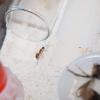Scientific Name: Acromyrmex versicolor
Common Name: Desert Leaf Cutter Ants
Distribution: Found throughout California, Arizona, New Mexico, Texas, and Upper Parts of Mexico
Queen size: 8 mm
Worker size: 2.5-7 mm
Natural Habitat: These are a desert ant found commonly in washes around large bushes and trees.
Circadian Activity: Can be active at any time of the day when weather conditions are suitable.
Mating Flight: Late July to early October. They typically fly the day after a rainstorm, shortly after the sun rises.
Queen Founding Method: Semi-claustral
Monogyne or Polygyne: In some areas polygyne. Best success is usually with single or two-three queen colonies
Average time from egg to worker: 4-6 weeks.
Recommended Temperature: It is best to keep these ants in relatively cooler temps. I’ve found the sweet spot is around 75F or 23-24C. The cardinal rule with keeping any fungus growing ant is to NOT heat them. Too much heat WILL KILL THE FUNGUS.
Recommended Humidity: Keep this species quite humid. This species is known for growing its fungus on the ceiling of their chambers due to the ground of the chambers being quite wet. A rule of thumb is that if the nest looks dry hydrate immediately.
Preferred Foods: Acromyrmex exclusively feed on the fungus they grow, but to fertilize the fungus, they will use a variety of organic matter. They seem to really like, and most people have had success giving them rose petals, clover leaves, steel cut oats, mesquite leaves, and fish pellets. No insects are needed as they will be left untouched by the colony.
Hibernation Details: This species does not need hibernation, but I have found that fungus growth is halted in the winter, and the fungus may even decrease. Also brood production will be halted or slowed in the winter.
Escape Barrier Methods: These ants are adept climbers but I have found that Fluon can stop them but be wary of silicone bridges.
Difficulty rating: This species is for intermediate keepers and above. While there is a stigma around leaf-cutters, they can be quite easy. If necessary temperature and humidity parameters are not met, colonies can quickly fail.
Bite and/or Sting rating: These do not sting, bite can be painful as these are ants specialized in cutting.
Special Care or Interesting Notes: I have found that giving these ants too much is not a thing. They will take what they want and leave the rest to come back for it later. Although my colony does go through a large handful of leaves in about a week or less.
Additional Links:
My colony: https://www.formicul...journal-mar-31/
AntWiki Page: https://www.antwiki....rmex_versicolor
Information submitted by ZTYguy
Edited by dspdrew, April 24 2022 - 10:47 AM.






















